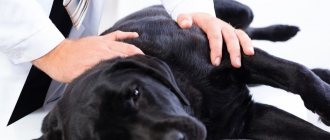In this matter, it is necessary to observe some safety measures and follow the recommendations of specialists. How to catch a dog if it runs away - let's look at the important nuances and rules of interaction with animals.
Stray dogs are often abandoned by their owners; they are not accustomed to street life. She may experience fear, hunger, pain, which poses a threat to the people around her. To minimize the risk of injury or disease transmission, you should familiarize yourself with how to properly catch a dog and what to do after catching.
Own or homeless
Let's separate the flies from the cutlets and figure it out: what kind of dog are we catching and why? If one of your own runs away - one conversation. If you have to help old ladies like this, like in the introduction, it’s completely different. It would be more appropriate to remain silent about the stray dog, because why catch him? But life situations are simply fantastic. For example, a neighbor always remembered her dog. He ran away a couple of years ago. And imagine the situation: you ran into this neighbor in the store, and you are returning home together. And she is suddenly surprised to recognize her dog in a stray dog running past. The same one who ran away many years ago.
The dog is shy because it is homeless. And the neighbor asks for help with catching the animal. How are we going to catch it?
Methods for pet dogs:
- Team.
- Imitation of the owner leaving.
- Delicacy.
- Dog whistle.
Let's talk about each method more specifically.
Using the command
Note that in this case the dog must be well trained and obey the owner. The question immediately arises: will a well-trained pet run away from its owner? Anything can happen. Even the smartest and well-mannered dog is an animal. And she may become “jammed” at the sight of a cat, for example. These are rare situations, but they do occur.
How to catch a dog using a command? Shout loudly and clearly: “Come to me!” The animal's inhibition processes will work as soon as it hears the command. And the pet will return to its owner. After the dog has approached its owner, under no circumstances should it be scolded or beaten. Understandably, the owner is angry. But if your pet develops a negative connection with the team, it will eventually stop approaching its owner. Because he knows that punishment or beatings await him.
You must silently take the dog on a leash and not let it off again until the end of the walk.
Puppy adaptation
If the adaptation of an adult dog takes on average several months, then a few weeks or even days are enough to tame a puppy. To do this, fulfill the following conditions:
- Protect your baby from four-legged family members with a pronounced territorial instinct using a transparent partition. This way, all inhabitants can get used to each other’s smell and appearance without direct physical contact.
- Give your new pet a personal corner with everything he needs. Expand the accessible area gradually to avoid puddles throughout the house.
- Entertain your puppy with active games and try not to leave him alone.
- Instill rules of behavior from day one. Use a diaper, feed strictly by the hour and in one place.
Avoid punishment using brute force and yelling. This method of influence will not give the desired result and will only scare the baby.
I'm leaving
Small dogs are much more prone to escape than their larger relatives. And how to catch a runaway, given the complete lack of training?
Catch up and attract attention by loudly calling your pet by name. This should work. And after the dog reacts and rushes to the owner, run away from it. At the same time, not forgetting to look at how the animal behaves. Does it run after its owner?
Arrange a sort of catch-up and pretend that the owner has decided to leave the dog. Small breeds are afraid to be left alone on the street; the pet will certainly not want to take risks. And he will run after the owner.
If we are talking about a large breed, then this option is suitable for teenage puppies and young dogs.
Reasons for “escape” while walking
If you are interested in a long-term solution to the problem, that is, teaching your dog not to run away and calmly let your pet off the leash, it is important to find out and eliminate the reasons for “running” during a walk.
In most cases, if a dog starts to run away, the owner decides that it cannot be subdued and puts up with this annoying factor.
Breed characteristics
Huskies, Malamutes and other northern dogs. Representatives of such breeds are hyperactive, and their genetics have a desire to run. Practice shows that even well-trained northern dogs often run away from their owners, especially if they do not receive sufficient physical exercise. It is better to walk them for life on a long, loose leash. You can only let your dog off the leash in fenced areas.
Laikas, greyhounds and other hound-type dogs. Representatives of such breeds tend to chase prey if they smell it. It is important to understand that when a dog smells prey, its attention and behavior are completely “managed” by the hunting instinct. The dog takes off and starts running, does not hear commands, does not pay attention to stimuli. To prevent escapes, the dog needs to be actively walked every day. In addition, you need to train your pet long and hard, reinforcing the execution of the call. To “compete with instincts” when teaching calling, it is better to use a whistle.
Dachshunds, Jack Russell Terriers and other burrowing dogs. Representatives of the breed are hyperactive and require very serious daily stress. If there is insufficient load, dogs regularly run away and can rarely find their way home on their own.
Beagles, Setters, Shorthaired Pointers and other gun breeds. The reasons for escapes and methods for correcting the situation are similar to those written above. However, there is a consoling point - gun dogs learn easier and faster.
The dog runs home
Most likely, the pet feels insecure or suffers from illness. The desire to quickly finish a walk is inherent in melancholic and elderly dogs.
A dog may run home if it is cold or uncomfortable. For example, short-haired dogs often try to return home quickly from a winter walk. In all other cases, the problem is solved by changing the approach to organizing the walk.
Escape to other dogs
If your pet runs to other dogs, then your ward lacks physical activity and socialization. Animals that live in a private home and rarely go out into the world are prone to escapes of this type. Lack of socialization has a detrimental effect on the psyche and health of the dog as a whole.
Toy and treat
How to catch a dog? With her favorite toy or treat.
First of all, the animal is called. Not just once, but constantly called by name. Not this way: “Jessie” and look after the rapidly running away pet. And we act like this: “Jesse-Jesse-Jesse-Jesse.” The dog reacted, we immediately show him his favorite toy. We wave to her, attracting the attention of our pet.
99% of dogs react to their toys. They want to play, they want to get it. And they lose interest in the stimulus they were chasing.
The same goes for treats. The dog is shown a treat if the distance allows this.
The method is suitable for those domestic dogs that chased a cat, for example. And they did not have time to escape far enough from the owner.
If the dog is scared and rushes into the distance, not making out the road, there is no time for toys and treats. You will have to run after her, appealing to the animal’s mind by calling by name.
Where to look for a missing cat?
What to do? The most important thing is not to panic, but to immediately analyze all possible escape options and take active action.
If you find that your cat does not meet you after work, does not respond to calls, or does not go to the bowls, this is a cause for concern. However, it is possible that the cat never left the apartment, but is simply sleeping soundly somewhere, having climbed into a hard-to-reach place from where it can get out on its own. This could be a closet where an animal sneaked in unnoticed while you were getting ready for work, a linen drawer inside a folding sofa, a shoe box that you put on a shelf.
Check all such nooks and crannies in the apartment to make sure the cat is not there. During the warm season, a cat can spend a lot of time on the balcony, so if your house has a balcony, make sure you don't accidentally lock the animal in there before leaving the apartment.
Popular articles Animals that break stereotypes about them
Fell out of the window?
If all attempts to find the fugitive in the apartment have failed, you should consider a more pessimistic scenario: the cat fell out of the window, attracted by the chirping of sparrows or the cooing of pigeons on a nearby window or balcony.
Immediately go downstairs to explore the area surrounding the house. There can be two options: either the animal crashed, and then, alas, a not very funny sight awaits you. If neither a cat nor signs of violent death were found under the windows of your apartment, there is hope that your pet is alive, but in shock tried to find a safe place where it hid.
Explore the surroundings
Carefully examine the entrance, floor by floor: there is a chance that the cat did not fall out of the window, but quietly slipped out of the apartment when you hesitated, closing the door. A cat can also hide in the entrance if it has fallen out of a window. Arm yourself with a flashlight and don’t miss a single nook in the entrance: in shock and confusion, the animal will want to hide in the farthest, inaccessible corner.
Take your cat's favorite toy, as well as a bag of food: attracted by the characteristic sound of the rustling bag, the cat may come out to meet you. Call the cat's name loudly, exploring the area around the house, basements, attics, don't be lazy to look under all the cars - cats often hide there. Also explore neighboring entrances and neighboring houses. Expand your search area in a spiral.
Word of mouth
If the search does not bring the desired result, it’s time to connect other resources: neighbors, acquaintances, grandmothers at the entrances, janitors, schoolchildren. Print out a lot of photos of your pet, as well as cards with your coordinates, and distribute them to everyone who can help or just happen to see your cat while walking.
Paradoxically, do not ignore dog lovers: many of them go on intense walks around the area, it is likely that someone could have come across your missing cat. In addition, pet owners in large cities have a developed sense of solidarity and belonging, so attracting such a resource produces results.
Ads with cat photos and contacts
Print lots of colorful notices with a photo and name and description of your cat's special features, age, gender and habits, indicate in the announcement where and when she disappeared.
Such notices should be posted in the entrances of nearby houses, in shops, at public transport stops, at post offices, in bank branches, in pet stores and veterinary clinics, on poles and fences. If there is a school not far from your house, take the time to go there and leave a packet of announcements for schoolchildren, promising a reward for finding and returning the animal.
dog whistle
What kind of innovation is this? And how will it be useful in catching a runaway pet?
This is a great way to catch a dog. But only if the animal knows its sound and reacts. Speaking of the whistle. It’s a good idea to teach your dog the command “Come to me!” on it. So that the pet develops a conditioned reflex to the whistle. I heard a whistle - I ran to the owner, they called me. If you teach your dog this, there will be no problems with calling.
What is good about an ultrasonic whistle for dogs? Only the animal hears it. The person does not hear the signals. That is, it is silent for the owner and very loud for his pet.
Another advantage of the whistle is that it can scare away aggressive stray dogs. We just tune it to a different frequency and whistle. The aggressor is unlikely to like the sound made. The dog will prefer to leave the field without a fight.
Whistle frequency is 170 kHz. That’s why a person doesn’t hear it, because our ear is capable of picking up signals up to 20 kHz. A dog's hearing, as we know, is more sensitive.
Valid at a distance of 450 meters. Therefore, the pet will hear the call, even if the owner has lost sight of the dog. And most importantly - a constant whistle in an emergency situation.
This is how they catch fugitives using an ultrasonic dog whistle.
New home training basics
In the new home, the pet will have to get to know the rest of the family and explore the territory. Be sure to help him at this stage and do not forget to allocate a personal space where he can be alone.
Meeting all family members
Before you get a four-legged friend, be sure to coordinate your plans with the rest of your household. The decision must be mutual. This is the only way your pet can live in a comfortable atmosphere.
Children get along best with animals, but sometimes they go too far. Babies are too intrusive and do not always calculate their strength when hugging. Talk to your child about the rules of communication before the arrival of a new family member.
Meeting other four-legged animals can make old-timers jealous, so it’s best to keep them at a distance for the first week. Try not to show affection to the newcomer in front of them and not to change your usual attitude towards your pets.
Getting to know the house
Remove all fragile, valuable and potentially dangerous items in advance. Buy more toys and leave them on the floor. This way, the pet will be able to not only sniff the new territory, but also taste some objects.
When getting to know the house, base it on the dog's behavior. If he is clearly interested, do not stop him from exploring the new environment, and if he is constrained and passive, do not insist on walking around all the rooms and give him time.
Setting up a place for a new pet
Each pet should have its own place where it can rest and be alone. Choose the quietest corner and place a comfortable bed or house in it.
During the first week, feed separately from other four-legged animals to avoid food aggression.
Buy your pet a personal feeder and water bowl so that he can get used to the new smells. Increase the portions themselves gradually, avoiding indigestion from an unusual diet.
If you have adopted a puppy, be sure to provide him with a place to go to the toilet. Use a diaper or litter tray.
Food
How to catch a dog if it doesn't come? She is not aggressive, she even wags her tail timidly. But he doesn’t want to come closer.
In this case, food that the animal likes will do. This could be a few pieces of sausage, a bag of wet dog food, or pieces of chicken. Place them on the ground next to you so that the animal can see the person's actions. The dog will become interested, and if it is hungry, then a few hesitant steps towards the catcher are guaranteed. Take a couple of steps back so that the dog comes closer.
The animal has approached, what to do next? Don't try to talk to her loudly. If a dog lived on the street for a long time, then it probably had to run away from people with loud voices more than once. She'll just get scared and run away. Or she will decide that she needs to defend herself.
It's better to show your location in a different way. Smacking your lips, for example, or gently slapping yourself on the knee or thigh.
The dog approaches hesitantly, wagging its tail? Great. Let him sniff you. Don't be afraid, the dog is peaceful. I would like to attack, I would have done it a long time ago. How to catch someone else's dog, and a stray one at that? Gently extend your hand, just a little, not all the way. To have time to pull back if necessary. The dog sniffed and is in no hurry to leave? Pet her and treat her with something tasty in addition to what was given to the animal earlier. That's it, the dog is ready to become a pet. Beckon and he will follow.
Catching a dog in need of help (video): methods and tips
Nets
A tool that requires a lot of skill and is not always suitable due to its large size (it can frighten the animal). More suitable for catching puppies in open areas. We do not recommend purchasing flying nets and net throwers because of their high capriciousness in operation and the need to very accurately determine the distance to the target.
Dog catchers
The advantage of this unit is the ability to catch dogs without human presence. They can be either homemade or factory-made. The photo shows an example of a factory dog catcher. In it, the door moves on an axis, slamming shut under the action of a spring. Link to the manufacturer: https://www.vector61.ru/production/trapping/kletka-lovushka-(sobakolovka) Manufacturer - the Vector enterprise, Rostov-on-Don, the second, less well-known manufacturer of trapping equipment in Russia.
It’s easy to make a dog catcher yourself, using iron reinforcing mesh (sold in hardware stores) and a simple design of a falling door that slides freely in the grooves (2) (that is, the door falls under its own weight). In the raised position, the door (1) is held by a pin (4) passing through a hole in it. The pin is mounted on a lever (3), to the end of which a rope (5) is tied. A bait (for example, a bone) is tied to the other end of the rope, which is lowered inside the dog trap, or it is tied to a thin plate - a pedal (6), upon which the dog steps on which will cause the lever to turn, the pin to come out of the hole in the door and the door to fall.
The door can be made of plywood. The lever is used to increase the traction when pulling the pin out of a rather heavy door. The dimensions of the dog trap are from 1 m in length and 50 cm in width and height. The larger the dog trap, the less afraid the dog will be to enter it. The simplest option would be to manually close the dog trap, when the pin (it doesn’t even need to be attached to the lever) is pulled out of an ambush by a long rope - however, in this case you will need to be personally present during the catch. In a dog trap, a “path” of food is laid out, and the main bait is located behind the pedal.
Syringe guns
Syringe guns are used to catch the most cautious dogs that will not go into a dog trap. Syringe launchers fire special “flying syringes”. They are sometimes incorrectly called darts. Difference between darts and syringes: A syringe is designed to hold a liquid drug and is quite large in size. The dart is small in size, like a small narrow metal arrow no more than 5 cm long. Designed for a special paste that is placed into the grooves on the dart. Typically, this paste is a muscle relaxant that is fatal to the dog. That is, darts are most often a weapon for shooting, not for catching alive. Although sometimes a paste of non-lethal Telazol or Zoletil powder is placed in the darts, this usually does not give normal results. Therefore, you need to use flying syringes with a volume of 3 ml or more.
Flying syringes have two chambers separated by a piston. A narcotic mixture is poured into the front, and a mechanism is located in the back that creates pressure, spraying the mixture into the animal’s body when it enters. Depending on the manufacturer and model, this mechanism is presented in two versions: 1) pressure is created by a spring (most domestic syringes), 2) pressure is created by compressed air (foreign syringes and some domestic ones). Usually you need to inflate the syringe with compressed air in advance using another, regular syringe (through the valve at the back, this is how Danish-made syringes are designed). Or the syringe itself is inflated with compressed air during the shot (so-called self-winding syringes - this is less reliable and is used only for small doses of the drug). The caliber (diameter) of syringes is different. Domestic syringes usually have a different caliber than imported ones.
A syringe gun is a pneumatic launcher that fires a syringe using compressed air or carbon dioxide. The simplest syringe gun is just a tube from which you blow the syringe out with the force of your lungs. More complex models have a cylinder into which air or gas is pre-pumped under pressure. Most domestic syringe guns need to be pumped with carbon dioxide from carbon dioxide fire extinguishers. The charge is enough for several dozen shots. Also, some new domestic and foreign syringe guns use cans of liquid carbon dioxide from gas-cylinder pneumatic pistols. Homemade syringe launchers and the simplest imported syringe launchers usually have a cylinder that is inflated with air using a conventional pump or car compressor, but the inflation is only enough for one shot.
The best syringe guns are syringe guns made by the Danish company DanI inject (Daninject). In Russia, its distributor is the company Zoospetspostavka. Link to the Zoospetspostavka website. But their syringe guns are expensive (from 100 thousand rubles), although reliable. Their advantage is the ability to smoothly adjust the pressure in the cylinder. You can only buy 3 or 5 ml syringes from them (1 piece costs about 2500 rubles), and you can make a syringe gun yourself. https://zoospecpostavka.ru/katalog/52-veterinarnyy-shpric-drotik
Daninject syringes and needles are reusable. The syringes are very durable and last for many months. They use pressure creation using compressed air pumped through a valve with another syringe. As a rule, syringes do not break, but get lost. The needles are less durable, but still strong. Connects very firmly to the syringe.
Homemade syringe guns.
Effective up to 10 m. The simplest syringe gun is a plastic or metal tube from which a syringe is blown out with the force of the lungs (up to 3 - 4 m). More complex models can be made from parts available at plumbing and automotive supply stores. They are based on air cylinders (of different origins), gas tees are hermetically connected to them, to which are attached: 1) a pressure gauge 2) an inflation valve (quick-release) 3) a car blowing gun. The barrel is a metal or plastic tube suitable for the caliber of a syringe.
Factory syringe guns.
Relatively cheap domestic syringe guns for domestic syringes. If you do not need to carry out large volumes of catching, especially very wild dogs, then you can use the following purchased syringes from Technopharm.
This is a blowpipe with a laser designator. https://tehnofarm.com/p217999035-duhovoj-metatel-lazernym.html
This is a thrower with a simple pump. https://tehnofarm.com/p218339974-pnevmaticheskij-metatel-letayuschie.html
These devices shoot at a distance of no more than 5 m. For a longer distance – up to 25 m – we recommend this device.
https://tehnofarm.com/p218339971-pnevmaticheskij-gazoballonnyj-metatel.html
You need to charge it from a fire extinguisher. However, unlike most other domestic syringe launchers, it allows you to regulate the pressure during the shot, which makes it possible to some extent to avoid too much impact of the syringe on the dog (and, therefore, less frightening of the animal).
In general, we recommend using either a blowpipe or low-power homemade syringe guns for short distances (up to 5 meters), and carbon dioxide syringe guns for long distances. Unfortunately, the inability to set the exact shot pressure is the problem with most domestic gas syringe guns, in which they are inferior to Daninject.
When learning to use a syringe gun, it is recommended to test it on dense foam rubber pads in order to select pressures for different distances and make sure that the impact will not be weak (so that the needle pierces the skin and enters deep enough so that the holes on the needle become free and the drug comes out), but not very strong. Practice with syringes filled with water. Remember that too strong a blow will cause great fear in the animal and it will run further, which will complicate its search.
When organizing a catch, try to block all the dog’s escape routes (close the holes in the fence or place people in the path of the animal’s possible running). Try not to disturb the animal before shooting. Use small food scattered on the ground so that the animal does not pay attention to you. Do not use large pieces, because the dog will grab them and immediately run away. Try to shoot from behind cover or from a car if the animal is distrustful. Try not to shoot at a moving animal - there is a danger of ricochets. Try to shoot at the thigh or neck. If the animal does not see that something has hit it, it is less afraid.
When chasing an animal that has been hit by a syringe, do not try to catch up or drive it. Your task is only to track where it will fall. Don't lose sight of him, but don't try to run right after him. The less the animal feels persecution, the better. In winter, use tracks in the snow to search.
Composition of the anesthesia mixture.
Two components:
- Xylazine (under the names xyla, rometar). We do not recommend its Xylavet variety (low quality). For an average dog: 2 – 3 ml. Relaxes, dulls, but does not induce sleep.
- Zoletil or Telazol. Supplied as powder. You can dilute it with 10 ml of water or 8 ml of xylazine (for a higher concentration of the solution). For an average dog, take 0.8 to 1.2 ml of this solution.
Both components are poured into one flying syringe. The total volume of the mixture is from 3 to 5 ml. Doesn't work right away. As a rule, the more zoletil in the mixture, the faster the animal falls asleep. Shoot either in the thigh or in the neck. Try to prevent the dog from reaching the syringe with its teeth (therefore, the neck is preferable). In any case, he falls asleep no earlier than three to five minutes later and can run away. It is especially difficult to find in bushes or difficult industrial areas. Use people stationed 50 - 100 m around the capture site to track the dog.
Do not use too much pressure in the syringe gun to reduce the pain from the impact of the syringe.
Networks.
Nets are used when dogs are driven into a room or passage from which there is no exit except one. Can be used when catching puppies crawling out of the den. Recently, an interesting net device has appeared - a tripod for catching adult dogs. It is easily made from pipes and a dense network. Replacement for dog trap for cautious dogs.
Video with practical examples of catching
Trapper loop
How to catch a dog? One option is a catch loop. But it is only suitable if there is somewhere to immediately place the dog. She will be stressed and it is possible that she will want to use her teeth after such an execution.
After you have managed to lure the dog and it has come close enough, a trapping noose is placed around its neck. In this case, it is necessary to avoid eye contact with the animal. It may perceive this as a threat and attack.
Ideally, after catching, place the dog in a cage prepared in advance for these purposes.
DIY noose leash
Making a braided choke collar for a dog is easy. You will need about 4 meters of nylon cord, three metal rings, universal glue, a piece of heat shrink tubing and strong synthetic thread. Thread the ropes through the ring and weave a braid from the cord of the required length with a small margin. The length of the noose is calculated as the circumference of the dog's neck minus the diameter of the ring. During the braiding process, a retaining ring is woven at a distance depending on the size of the collar. Having completed the weaving, thread the end of the braid into the second ring, bend it and scorch it in the flame of a candle or lighter, fusing the bent ends with the braid behind the ring. For greater reliability, wrap the joint tightly with thread and glue it. Also secure the retaining ring with a thread to the glue.
Since it is not always possible to do this carefully, before fixing the ring, you can thread the ends of the cord into a heat-shrink tube and, when finished, cover the connection point with it.
Trap
We've covered almost every dog catching option, from food to dog whistles. The most difficult but interesting one remains - the trap.
What is this trap? A large cage with an automatic mechanism. The animal enters it and finds itself in a trap. The mechanism works, the cell closes.
This method is suitable for a summer cottage. If a stray dog gets into the habit of walking, because in the city it is virtually impossible to implement such an idea. There is no place or opportunity to wait for a dog with such a trap.
Cage traps come in different designs and sizes. It is necessary to focus on the approximate size of the animal. Place such a trap in the place where the dog appears most often. Place on a hard and flat surface.
It’s a good idea to disguise the mechanisms and give the cage itself an attractive appearance. Place a blanket in it and cover it with a blanket on top. Be sure to put food in the trap; the dog will find this option the most attractive. A ready-made shelter with food where you can feel safe, especially in the dark.
It is necessary to remove all sticks, stones and other paraphernalia from the door that could interfere with the closure of the structure.
Remember that the trap is designed for a certain size and weight of the dog. If the catcher thinks that the dog is small and its weight cannot affect the operation of the trap mechanism, you can put something heavy inside. A few bricks, for example. Cover them with a blanket and, as mentioned above, put food on the blanket.
Trapping service
There is a dog catching service in every city. You can find out where to call about stray dogs on the websites of utility companies. For example, in Perm such a service is located on the street. Solikamskaya, 271. You can contact them and call a team by phone number 263-14-94.
The powers of municipal animal control services include:
Note! Catching a stray animal is not so easy; it requires certain knowledge and skill. Before starting work, a dog catcher undergoes special training courses.
Municipal Service Catchers
The department for catching homeless animals includes a dispatcher who can be contacted with a statement (a sample usually hangs in the department above the table on the wall) or by telephone. Both individual residents and organizations serving local areas, building managers, and managers of private housing construction can contact the service.
All appeals are entered into the registration log indicating the applicant’s data, date of appeal, date of departure for this signal. The company has at its disposal vehicles equipped for these purposes, a set of fishing equipment, which includes syringes, loops, snares, nets, cages for puppies, and personal protective equipment against animal bites.
Services for catching stray dogs
Actions after the dog is caught
You managed to catch a stray dog. She is purebred, obviously ran away from her owners. What to do next?
Take it home. This is easier with small dogs than with large ones. The catcher is calmer. Wash, feed and place an ad on your city’s portal. Post advertisements about the found pet on breed forums and social networks. Post it on the free bulletin board.
Of course, it is better to give the dog back to its previous owners. But what to do if time passes, no one responds, and there is no way to keep it forever? There is nothing left to look for new owners.
Benefits of Trapping
According to British economists, as a result of preventive measures to regulate the number of stray dogs, costs from 1989 to 1998 were reduced by 60 million pounds sterling in just one year. The attitude towards our four-legged brothers has improved.
Shelters
In every country there is a service for catching stray dogs, whose responsibilities include catching stray dogs and placing them in shelters. Shelters, in turn, take care of their residents and try to find them homes for a comfortable stay.
For your information! After the agreed period, unclaimed animals must be euthanized to make room for new arrivals.
Wounded, sick, old, aggressive dogs that pose a danger to society are euthanized. Euthanasia of animals is much more humane than condemning them to terrible, half-starved conditions in overcrowded shelters.
Temporary shelters
How to keep your dog safe?
Cases are different. And a calm pet can run away. Buy a name tag. It is hung on the dog's collar. The tag indicates the owner's phone number and the dog's name. It usually looks like this: “Jack. 8-123-456-78-90. Reward." Some write more touching options like: “I want to go to my mother,” “Bring me home,” “Help me return to my parents.” Provide a phone number and offer a reward.
An electronic chip is a universal means for dog safety. According to it, the owner will be identified at the veterinary clinic. Of course, we are talking about clinics that have equipment for reading information.
No one has yet canceled the stigma. Most purebred dogs have it. Placed either in the ear or on the stomach. Using the brand, you can find the kennel where the dog was purchased, or find information about the owner on the Internet. The brand number is entered into the search engine, and if the dog is registered in the pedigree database, information about the breeder and owner is displayed.
Let's show it with an example. We drive in the word “stamp”, and then the letters and numbers indicated in it. It's simple.
Drive into a confined space
You can lure a dog with food into an entrance, car, basement or garage. If the animal is in a confined space, it will be much easier to cope.
It is important to stock up on plenty of dry food or pieces of meat. You should act carefully and calmly. It may take a long time and sometimes several attempts to achieve a positive result.
If you simply throw a large piece of meat at a distrustful animal, nothing will happen. You need to slowly place pieces of food at a short distance from each other and wait for the right moment.
It is advisable to act in pairs. In this case, one person lures the dog into a confined space, and the second person blocks the exit. If there is no partner, then you should take a position on the side and throw food in front of you. In this case, you will be able to independently block the path of an animal that has gone ahead.
Let's summarize
The main purpose of the article is to tell readers how dogs are caught. How to call dogs, what methods are used when catching.
Key aspects:
- They catch their dog with the help of a command, an attempt by the owner to get away from the pet, a treat or a toy. Another way is to use a dog whistle.
- A stray or strange animal can be lured with food, caught using a noose or a special trap.
- After the dog is caught, new or previous owners are found for it.











